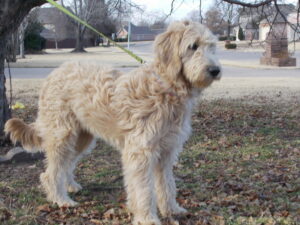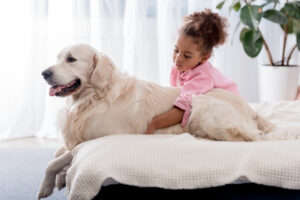In 1911, the Golden Retriever breed was accepted in the British Kennel Club (KC) while it was accepted in the American Kennel Club (AKC) in 1934. Throughout time, the Americans took a different standard of breeding to match the preferences of the American market while the British diverted their efforts to suit the European taste.

Clarifying the Names
The American Golden Retriever and English Creme Golden Retriever are both generally speaking Golden Retrievers. Wherever you are in the world, your Retriever will be registered under “Golden Retriever” with no additional sub-specification in the registry. Take note that English Crème Golden Retrievers are simply called “Golden Retrievers” throughout Europe and the rest of the world. In the United States, however, they are often called English Creme Golden Retriever simply to differentiate it from the American ones, due to their difference in color and other qualities. In other words, English Creme is a coined term to differentiate the breeding qualities between
the American and the English ones. Other names for the English Crème Golden Retrievers are White Golden Retrievers, European-style Golden Retrievers, English Golden Retrievers, Imported Golden Retrievers, British Golden Retrievers or simply English Cremes.
Therefore, if you’d follow all technical correctness, the English Cream Golden Retriever is basically “a Golden Retriever bred to the KC standards” and an American Golden Retriever is “a Golden Retriever bred to the AKC standards.”
Presented below are the major differences between the American Golden Retriever as bred by the AKC and the English Creme Golden Retriever of the KC. To reiterate, an American Golden Retriever are bred to the AKC standards, while the English Retriever are bred to the KC standards. The differences of these breeding standards are presented as follows.
Coat Characteristics and Color
The most obvious difference between the two retrievers is the color of their coats.
American Golden Retriever
The AKC describes an American Golden Retriever’s color to be “rich, lustrous golden of various shades”. Extremely dark or extremely light colors are not accepted within the breeding standards. This would mean that judging of the acceptability of color is, to an extent, left to the judge’s discretion.
English Cream Golden Retriever
The KC describes the English Cream Retriever to be of the shades of cream and to some extent gold. Mahogany and reds are not accepted.
Presented below are the specs of the coat, quoted from the AKC and KC standards, respectively:
AKC Coat Characteristics: Dense and water-repellent with good undercoat. Outer coat firm and resilient, neither coarse nor silky, lying close to body; may be straight or wavy. Untrimmed natural ruff; moderate feathering on back of forelegs and on underbody; heavier feathering on front of neck, back of thighs and underside of tail. Coat on head, paws, and front of legs is short and even. Excessive length, open coats, and limp, soft coats are very undesirable. Feet may be trimmed and stray hairs neatened, but the natural appearance of coat or outline should not be altered by cutting or clipping.
KC: Flat or wavy with good feathering, dense water-resisting undercoat.
In layman’s terms, this means that American Goldens have longer fur and a thicker coat. English Creams have relatively shorter coats and tend to be wavier. The Golden Retrievers were originally bred to be retrieving dogs which is why their coat was designed to be water-resisting and thick enough to withstand rougher terrains which includes wounds from bushes, etc.

American Golden Retriever
Head
Broad skull, and arched laterally and longitudinally to some degree but without prominence on the occipital bones or forehead. It has a deep and wide foreface which is almost as long as the skull. Its muzzle is straight, bending smoothly into the skull. Flews have no heaviness. Whiskers can be removed but is not preferred.
Eyes
Broad skull, and arched laterally and longitudinally to some degree but without prominence on the occipital bones or forehead. It has a deep and wide foreface which is almost as long as the skull. Its muzzle is straight, bending smoothly into the skull. Flews have no heaviness. Whiskers can be removed but is not preferred.
Neck
Neck is medium long and merges into well laid back shoulders. Neck provides a muscular and sturdy physique and appearance.
Ears
Ears are more of short with the front edge attached just above the eyes and fall close to the cheeks. When the ears are pulled forward, it should just be about able to cover the eye. Hound-like and low wears are faulted.

English Creme Golden Retriever
Head
English Cremes have a very well-chiseled and balanced head, and its skull is broad without coarseness. A powerful, wide and deep muzzle and the foreface length is about the length from stop to occiput.
Ears
English Cremes have moderately sized ears and set at approximate level with eyes.
Eyes
Eyes are dark brown with dark rims, and are well set apart.
Neck
Neck is of good length and is muscular and clean.
Aside from these specs for each breeding standard, the head of American Golden Retrievers are slightly smaller than those of the English Cremes, which is specifically visible in males. This relates to the fact that the necks of English Cremes are relatively more clean and muscular to support the bigger head.
In KC standard, there is no strict rule on clipping, whisker trimming, grooming and so on, as compared to the AKC where these things are seen of great significance. In KC standards, the main focus is to make a great pedigree with ideal offspring, making superficial changes such as trimming irrelevant to their standard.
In terms of muzzle and foreface, AKC aims for straight muzzles and the foreface to be the length of the skull. This accounts of the American Golden’s muzzle to be smaller and more conical in shape. The KC standard aims for more laconic muzzles and the length of the foreface to be the length from stop to occiput. This accounts for English Cremes to have wider and bigger muzzles with strong jaws.
In terms of eyes, the eyes of American Goldens are wider apart as compared to English Cremes. In terms of ears, AKC breeds the Goldens to be well behind and above level of eyes. KC breeds them to have the ears to be at level with eyes. This accounts for the rather different faces of the English Cremes and the American Goldens.

Health and Life Expectancy
There are certain health differences between the American Goldens and the English Creme which contribute to their life expectancy. American Goldens have a significantly higher chance of getting cancer as compared to English Cremes. This is based on research and statistics done. The median age of American Goldens is 10 years and 8 months, while the median age for English Cremes is 12 years and 3 months.
Overall Body Built
English Cremes are bigger boned, bulkier and also have blockier heads as compared to American Goldens.
AKC Height: 23 to 24 inches for males at withers; 21.5 to 22.5 inches for females
AKC Weight: 65 to 75 pounds for males; 55 to 65 pounds for females
KC Height: 22 to 24 inches for makes at withers; 20 to 22 inches for females
KC Weight: no weight specification
In terms of topline and hindquarters, presented below are the specs, quoted from the AKC and KC, respectively:
Topline
AKC: Strong and level from withers to slightly sloping croup, whether standing or moving. Sloping backline, roach or sway back, flat or steep croup to be faulted.
KC: Calls for level top line.
Hindquarters
AKC: Strongly muscled. Profile of croup slopes slightly; the pelvic bone slopes at a slightly greater angle (approximately 30 degrees from horizontal). In a natural stance, the femur joins the pelvis at approximately a 90-degree angle; stifles well bent; hocks well let down with short, strong rear pasterns.
KC: Loin and legs strong and muscular, good second thighs, well bent stifles. Hocks well let down, straight when viewed from rear, neither turning in nor out.
English Cremes have a more leveled topline with legs straighter while American Goldens mostly have slightly sloping topline with their legs standing more out. KC standard is very straightforward on this matter: level topline!
AKC allows for (slightly) sloping croup (back part) while KC prefers the dogs’ natural back which is not a dramatic sloping one.
Tail
AKC: Tail well set on, thick and muscular at the base, following the natural line of the croup. Tail bones extend to, but not below, the point of hock. Carried with merry action, level or with some moderate upward curve; never curled over back nor between legs.
KC: Set on and carried level with back, reaching to hocks, without curl at tip.



